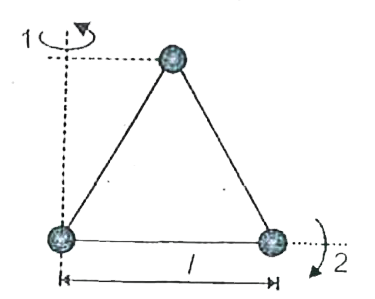Six identical particles each of mass m are arranged at the corners of a regular hexagon of side length L. If the mass of one of the particle is doubled, the shift in the centre of mass is
L
6L/7
L/7
L√3
The correct Answer is:C
To find the shift in the center of mass when one of the particles' mass is doubled, we can follow these steps:
Step 1: Determine the initial center of mass of the system
The center of mass (COM) of a system of particles is given by the formula:
→RCOM=1M∑imi→ri
where M is the total mass of the system, mi is the mass of each particle, and →ri is the position vector of each particle.
For six identical particles, each of mass m, arranged at the corners of a regular hexagon, the total mass M is:
M=6m
The position vectors of the particles can be represented as follows (assuming the hexagon is centered at the origin):
- Particle 1: →r1=(L,0)
- Particle 2: →r2=(L2,L√32)
- Particle 3: →r3=(−L2,L√32)
- Particle 4: →r4=(−L,0)
- Particle 5: →r5=(−L2,−L√32)
- Particle 6: →r6=(L2,−L√32)
Now, we can calculate the center of mass:
→RCOM=16m(→r1+→r2+→r3+→r4+→r5+→r6)
Calculating the x-coordinates:
xCOM=16m(L+L2−L2−L−L2+L2)=16m(0)=0
Calculating the y-coordinates:
yCOM=16m(0+L√32+L√32+0−L√32−L√32)=16m(0)=0
Thus, the initial center of mass is at the origin (0,0).
Step 2: Modify the mass of one particle
Now, let’s double the mass of one of the particles. We can choose particle 1 for this purpose. The new mass of particle 1 becomes 2m, while the other particles remain m.
Step 3: Calculate the new center of mass
The new total mass M′ of the system is:
M′=5m+2m=7m
Now, we recalculate the center of mass with the new mass distribution:
→R′COM=1M′(2m→r1+m→r2+m→r3+m→r4+m→r5+m→r6)
Calculating the x-coordinates:
x′COM=17m(2mL+m(L2)+m(−L2)−mL+m(−L2)+m(L2))
This simplifies to:
x′COM=17m(2mL+0−mL)=17m(mL)=L7
Calculating the y-coordinates:
y′COM=17m(0+m(L√32)+m(L√32)+0−m(L√32)−m(L√32))=0
Thus, the new center of mass is at (L7,0).
Step 4: Calculate the shift in the center of mass
The shift in the center of mass is given by the difference between the new and the old center of mass:
Shift=(L7−0,0−0)=(L7,0)
Final Answer
The shift in the center of mass is L7 in the x-direction.
---
- Particle 2: →r2=(L2,L√32)
- Particle 3: →r3=(−L2,L√32)
- Particle 4: →r4=(−L,0)
- Particle 5: →r5=(−L2,−L√32)
- Particle 6: →r6=(L2,−L√32)
Topper's Solved these Questions
- SYSTEM OF PARTICLESBook:NARAYNAChapter:SYSTEM OF PARTICLESExercise:Level-III
Explore 66 Videos
- SYSTEM OF PARTICLESBook:NARAYNAChapter:SYSTEM OF PARTICLESExercise:NCERT based questions
Explore 15 Videos
- SYSTEM OF PARTICLESBook:NARAYNAChapter:SYSTEM OF PARTICLESExercise:Level-1(C.W.)
Explore 64 Videos
- PHYSICAL WORLDBook:NARAYNAChapter:PHYSICAL WORLDExercise:C.U.Q
Explore 10 Videos
- SYSTEM OF PARTICLES AND ROTATIONAL MOTION Book:NARAYNAChapter:SYSTEM OF PARTICLES AND ROTATIONAL MOTION Exercise:EXERCISE - IV
Explore 39 Videos
Similar Questions
Four identical particles each of mass 1 kg are arranged at the corners of a square of side length 2√2 m.If one of the particles is removed,the shift In the centre of mass is
View SolutionSix point masses of mass m each are at the vertices of a regular hexagon of side l. Calculate the force on any of the masses.
View Solution
Knowledge Check
Four identical particles each of mass m are arranged at the corners of a square of side length l. If the masses of the particles at the end of a side are doubled, the shift in the centre of mass of the system.
Al6Bl6√2Cl√2Dl5√2Four identical particles each of mass m are arranged at the corners of a square of side length l. If the masses of the particles at the end of a side are doubled, the shift in the centre of mass of the system.
A0.375mB0.25mC0.125mD0.475mThree particles each of mass m are arranged at the corners of an equililateral triangle of side L. If one of masses is doubled. The shift in the centre of mass of the system
AL√3BL4√3C√3L4DL2√3
Three particles each of mass 2kg are at the corners of an equilateral triangle of side √3m. If one of the particles is removed, the shift in the centre of mass is
View SolutionSix particles each of massm are placed at the corners of a regular hexagon of edge length a. If a point mass m0 is placed at the centre of the hexagon, then the net gravitational force on the point mass is
View SolutionThree identical particles each of mass 0.1kg are arranged at three corners of a square of side √2m. The distance of the centre of mass from the fourth corners is
View SolutionThree identical particles each of mass "m" are arranged at the corners of an equiliteral triangle of side "L". If they are to be in equilibrium, the speed with which they must revolve under the influence of one another's gravity in a circular orbit circumscribing the triangle is
View SolutionThree particle each of mass m are placed at the corners of equilateral triangle of side l

Which of the following is/are correct ?
View Solution

